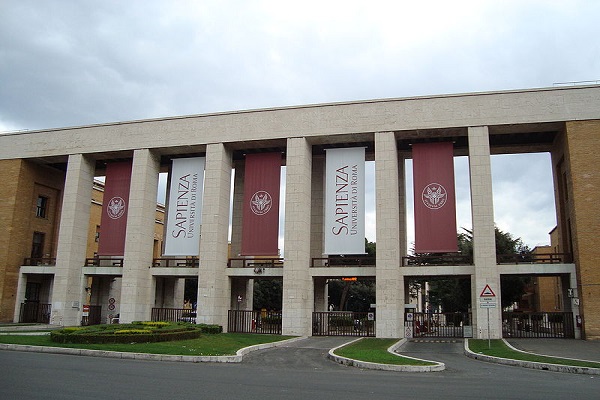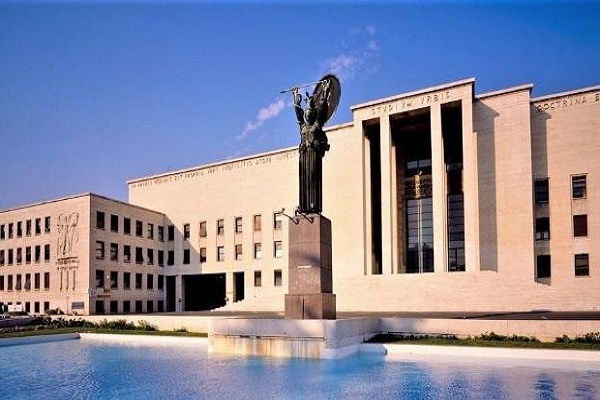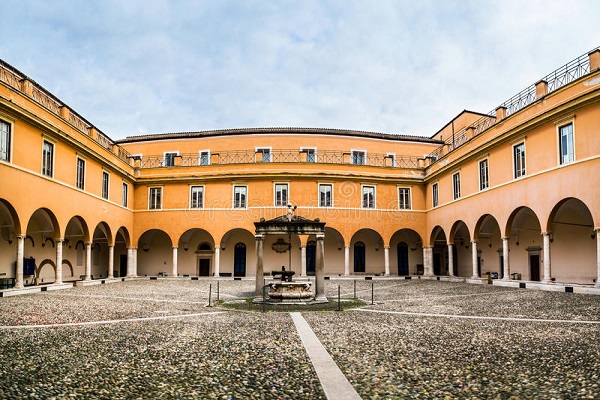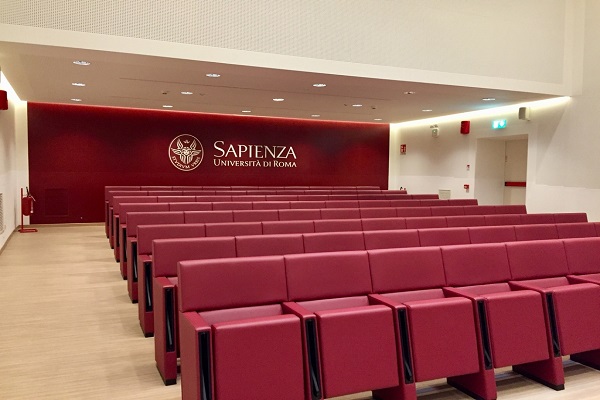University Rankings
- QS World University Rankings 132
- Times Higher Education World University Rankings 18
- Academic Ranking of World Universities 222
- QS Sustainability Ranking 150




Overview and History
Sapienza University of Rome, officially known as Università degli Studi di Roma “La Sapienza,” was founded in 1303 by Pope Boniface VIII. As one of the oldest universities in the world, Sapienza has been a major center for learning, research, and intellectual development for over 700 years. Originally established as a papal institution to provide ecclesiastical studies, the university has grown over the centuries into a large, public, secular institution.
Throughout its long history, Sapienza has played a key role in the cultural, scientific, and political life of Italy and Europe. Many influential figures in science, the arts, politics, and philosophy have studied or taught here. Sapienza’s name, meaning “wisdom,” reflects its commitment to knowledge, innovation, and critical inquiry.
Campus and Facilities
Sapienza’s main campus, known as Città Universitaria, was designed by the prominent Italian architect Marcello Piacentini and opened in
Academic Programs
The university also operates several specialized campuses and facilities, including the Policlinico Umberto I, one of the largest teaching hospitals in Italy. Sapienza maintains research centers in fields such as physics, engineering, and archaeology, as well as a number of cultural museums, including the Museum of Classical Art and the Museum of Physics. Its extensive library system includes one of the most important academic libraries in the country.
Research and Innovation
Sapienza offers a comprehensive range of academic programs across virtually every field of study. Its programs include undergraduate, graduate, and doctoral degrees, as well as postgraduate specialization courses and advanced research opportunities.
The university has over 280 degree programs and more than 200 specialized training courses. Many programs are taught in Italian, but Sapienza also offers a growing number of master’s and doctoral programs in English, designed to attract international students. Several of these programs are part of international partnerships and lead to double or joint degrees.
Sapienza is organized into numerous faculties and schools, including:
Faculty of Architecture
Faculty of Civil and Industrial Engineering
Faculty of Information Engineering, Informatics, and Statistics
Faculty of Law
Faculty of Medicine and Dentistry
Faculty of Pharmacy and Medicine
Faculty of Political Science, Sociology, and Communication
Faculty of Humanities and Philosophy
Faculty of Economics
These faculties cover the humanities, social sciences, natural sciences, engineering, technology, health sciences, and legal studies, providing students with a wide array of academic pathways.
Internationalization
Sapienza is recognized as one of Italy’s leading research institutions and is part of international research networks such as the European University Association (EUA) and the Mediterranean Universities Union (UNIMED).
The university consistently ranks among the top Italian and European universities in global rankings. According to international ranking systems like QS and ARWU, Sapienza stands out particularly in fields such as classics, archaeology, physics, and engineering.
Sapienza’s research centers contribute to significant advancements in areas including space science, biomedical research, materials science, artificial intelligence, and cultural heritage conservation. The university fosters innovation through collaborations with national and international institutions, industries, and government agencies.
Student Life
Sapienza is deeply committed to internationalization. The university enrolls over 7,000 international students and has more than 400 partnerships with universities worldwide. It actively participates in European and global programs, including Erasmus+, Horizon Europe, and bilateral research and exchange initiatives.
International students can choose from a range of degree programs taught in English, and the university provides dedicated support services, including orientation, Italian language courses, visa assistance, and housing guidance. Sapienza also offers double-degree and joint-degree programs in collaboration with prestigious institutions abroad, enhancing the global reach and reputation of its academic offerings.
Admissions and Tuition
Sapienza’s large student body, numbering over 115,000, creates a dynamic and diverse campus environment. Students can join more than 150 student organizations and clubs that cover academic, cultural, political, and social interests.
Cultural life at Sapienza is enriched by theater performances, concerts, exhibitions, and university-led cultural initiatives. Students also have access to sports facilities, gyms, and organized sports competitions, including inter-university tournaments.
Student media is another active part of Sapienza life, with student-run publications, radio stations, and digital media projects providing platforms for creative expression and debate. Located in Rome, one of the most historic and culturally vibrant cities in the world, Sapienza offers students unparalleled opportunities for cultural enrichment, networking, and career development.
Notable Alumni and Achievements
Sapienza University welcomes both Italian and international applicants. Admission requirements vary depending on the program, with some requiring entrance examinations, portfolio submissions, or selection based on prior academic performance.
Tuition fees are relatively low compared to many international institutions. Fees are calculated on a sliding scale based on family income, typically ranging from a few hundred to several thousand euros per year. Sapienza offers a wide range of financial aid options, including scholarships, merit-based awards, and grants for both domestic and international students.
Throughout its long history, Sapienza has produced many distinguished alumni who have made significant contributions to science, culture, politics, and the arts. Notable alumni include:
Enrico Fermi, Nobel Prize-winning physicist
Daniel Bovet, Nobel Prize-winning pharmacologist
Luigi Einaudi, former President of Italy
Maria Montessori, pioneering educator and physician
Sapienza’s research achievements have shaped important fields, from nuclear physics and medicine to archaeology, space exploration, and artificial intelligence. The university’s ongoing research and innovation continue to place it at the forefront of academic and scientific development.
News & Updates
 UCL’s Global Impact: Addressing World Challenges Through Interdisciplinary Research
UCL’s Global Impact: Addressing World Challenges Through Interdisciplinary Researchby Piyush Chauhan
December 15, 2025
 Exploring MIT’s Pioneering Research in Artificial Intelligence and Future Technologies
Exploring MIT’s Pioneering Research in Artificial Intelligence and Future Technologiesby Piyush Chauhan
December 15, 2025
 How Liberty University Prepares Students for Purposeful Careers Through Faith-Based Learning
How Liberty University Prepares Students for Purposeful Careers Through Faith-Based Learningby Piyush Chauhan
December 15, 2025
 Navigating New York City: Columbia University’s Unique Urban Advantage for Students
Navigating New York City: Columbia University’s Unique Urban Advantage for Studentsby Piyush Chauhan
December 15, 2025
 Transform Your Career: The Open University’s Flexible Path to Lifelong Learning
Transform Your Career: The Open University’s Flexible Path to Lifelong Learningby Piyush Chauhan
December 14, 2025
Courses & Fees
Frequently Asked Questions
Sapienza University of Rome does not officially publishes acceptance rate. However, as per some unofficial sources, Sapienza University of Rome acceptance rate is 39%. This shows that Sapienza University of Rome is very selectiive in admissions. Thus making it little bit hard for international students to get into Sapienza University. Please note that the data on the acceptance rate given above is taken from an unofficial source, therefore, it is subject to vary.
International students must meet the following requirements at the time of application at Sapienza University of Rome:
Undergraduate Eligibility
For applying to baccalaureate programmes, students must have a high school certificate or diploma, which is earned after studying for 12 years. Certain programmes such as BSc in nursing and BSc Bioinformatics require students to clear the admission test conducted to test a student's ability in the relative field of study. Also, an average GPA of 2.8 is required to get selected in most of the programmes.
Postgraduate Eligibility
For applying to master's degrees, the candidates must have a bachelor's degree in the respective field along with a high school diploma. These two certificates should contribute towards 15 years of studies that include studies of at least 3 years at the university level.
Some of the courses also require the student to earn ECTS in their respective areas. For example, to apply for the MSc Atmospheric Science and Technology, the student must have at least 72 ECTS overall, in which the 18 ECTS should be from the Business area, and the remaining credits must be earned from either Law, Mathematics/Statistics, Quantitative Analysis, or Economics.
Sapienza University of Rome offers a number of undergraduate and postgraduate programs to international students. International students can apply online to any course in Sapienza University of Rome. However, there is no application fee for international students applying to Sapienza University of Rome. International studetns are advised to check the minimum eligibility for the course before applying at Sapienza University of Rome.
Sapienza University of Rome offers a wide range of programme for its international students. Sapienza University offers 301 undergraduate & postgraduate, and 93 PhD programs. One of the most popular programme among international students is MS. Sapienza University offers MS with a duration of 2 to 6 years. Also, the university offers MS programme in various specializations such as MSc Management Engineering, MSc Electrical Engineering, MSc Cognitive Neuroscience, Master of Science in Energy Engineering, MSc Nanotechnology Engineering, MSc Chemical Engineering, and more. Sapienza University of Rome tuition fee for MS program is INR 3L. International students must meet all the admission requirements for MS programme at the university. The basic eligibility criteria for international students include a 3-year bachelor's degree from a recognised university in a relevant discipline
